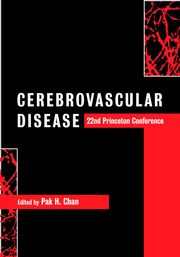Book contents
- Frontmatter
- Contents
- List of contributors
- Preface
- Acknowledgments
- Part I Special lectures
- Part II Oxidative stress
- Part III Apoptosis
- Part IV Hot topics
- Part V Hemorrhage, edema and secondary injury
- Part VI Inflammation
- 18 Inflammation and stroke: benefits or harm?
- 19 TNF-α and ceramide are involved in the mediation of neuronal tolerance to brain ischemia
- 20 Sites and mechanisms of IL-1 action in ischemic and excitotoxic brain damage
- 21 Protease generation, inflammation and cerebral microvascular activation
- Part VII Gene transfer and therapy
- Part VIII Neurogenesis and plasticity
- Part IX Magnetic resonance imaging in clinical stroke
- Part X Risk factors, clinical trials and new therapeutic horizons
- Index
- Plate section
20 - Sites and mechanisms of IL-1 action in ischemic and excitotoxic brain damage
from Part VI - Inflammation
Published online by Cambridge University Press: 02 November 2009
- Frontmatter
- Contents
- List of contributors
- Preface
- Acknowledgments
- Part I Special lectures
- Part II Oxidative stress
- Part III Apoptosis
- Part IV Hot topics
- Part V Hemorrhage, edema and secondary injury
- Part VI Inflammation
- 18 Inflammation and stroke: benefits or harm?
- 19 TNF-α and ceramide are involved in the mediation of neuronal tolerance to brain ischemia
- 20 Sites and mechanisms of IL-1 action in ischemic and excitotoxic brain damage
- 21 Protease generation, inflammation and cerebral microvascular activation
- Part VII Gene transfer and therapy
- Part VIII Neurogenesis and plasticity
- Part IX Magnetic resonance imaging in clinical stroke
- Part X Risk factors, clinical trials and new therapeutic horizons
- Index
- Plate section
Summary
Cytokines and ischemic brain damage
Cytokines are polypeptides that include the families of interleukins (IL-1), tumor necrosis factors (TNF), interferons and growth factors with diverse actions on development, inflammation, tissue injury and repair in almost all cells in the body. The past decade has witnessed increasing interest in the functions and importance of cytokines in central nervous system biology and pathology.
Most cytokines are produced at low levels in healthy adult brains, but many are upregulated rapidly in response to injury, infection or inflammation in the brain including cerebral ischemia. The influence of cytokines on ischemic brain damage appears to be diverse and complex. While several cytokines have clearly identified neurotrophic or neuroprotective effects (e.g., IL-6, insulin-like growth factor (IGF), nerve growth factor (NGF), fibroblast growth factor (FGF), transforming growth factor-β (TGF-β)), others have been implicated as mediators of cell damage (most notably IL-1), while for some (such as TNF-α) both neuroprotective and neurotoxic effects have been identified. This review will focus on the actions of IL-1 on ischemic brain damage and recent findings about its mechanisms of action.
IL-1 expression in stroke
IL-1, IL-1α and IL-1β, and IL-1 receptor antagonist (IL-1ra) are all rapidly produced in response to experimental stroke and excitotoxic and traumatic brain injury in rodents. Temporal studies on expression indicate that IL-1β is produced most extensively and rapidly, initially by microglia and meningeal macrophages and later by astrocytes and invading immune cells.
- Type
- Chapter
- Information
- Cerebrovascular Disease22nd Princeton Conference, pp. 237 - 246Publisher: Cambridge University PressPrint publication year: 2002



